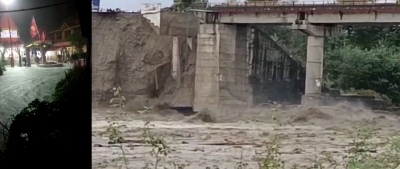U'khand devastation could have been worse but for early forecast, warnings: IMD
By IANS | Published: October 20, 2021 03:00 PM2021-10-20T15:00:09+5:302021-10-20T15:05:15+5:30
New Delhi, Oct 20 The loss of three dozen lives and the damage to infrastructure in Uttarakhand due ...

U'khand devastation could have been worse but for early forecast, warnings: IMD
New Delhi, Oct 20 The loss of three dozen lives and the damage to infrastructure in Uttarakhand due to extremely heavy rainfall could have been worse had the authorities not paid heed to the India Meteorological Department's (IMD) early warnings and forecast days in advance.
Thanks to the timely forecast, the state government could hold meetings, keep rescue teams ready and provide assistance before and after the torrential rains.
The IMD issued forecast and early warnings for all major weather events heavy rainfall, thunderstorms, lightning, heavy snowfall, cold waves, heat waves and cyclones. More lives could be saved and damage to infrastructure prevented due to early warning in case of heavy cyclones and heat waves.
"In case of cyclone, the prediction by IMD about the location of landfall are comparable to any international forecasters. We are second to none. During the last five years, there has been a significant improvement in tracking a cyclone's path," IMD Director General Mrutyunjay Mahapatra stated during a special lecture series as part of the IMD's 'Azadi Ka Amrut Mahotsav'.
The number of deaths in the Odisha Super Cyclone of 1999 was 10,000 plus and compared to that, the fatalities in recent years have come down to single digits in most cases.
On forecasting and warning skills of IMD for their core competency, rainfall prediction, the probability of detection (POD) of heavy rainfall at meteorological subdivision levels increased from 50 per cent in 2014 to 77 per cent in 2020 for 24 hours (day 1); from 48 per cent to 70 per cent for 48 hours (day 2) and from 37 per cent to 66 per cent for 72 hours (day 3) lead period.
"The heavy rainfall forecast issued in 2020 five days ahead has the accuracy of 59 per cent against 50 per cent in 2014 only 24 hours ahead. Thus, there is a gain of four days in lead period of forecast of heavy rainfall in 2020 compared to 2014," Mohapatra said.
As another outcome of an improved early warning system, Mohapatra cited how IMD has collaborated with the National Disaster Management Authority (NDMA) to devise the National Guidelines for the management of heat waves and with the states formulating Heat Action Plans reduced the heat-related mortality and morbidity in the country.
Because of the heat related mortality, the number of lives lost in 2015 was 2040, in 2016 it was 1111, it came down to 384 in 2017 and by 2018, the number of registered deaths due to heat related mortality was just 25. The deaths in 2019 were 226 and that in 2020 were just four, Mohapatra said on Tuesday.
The number in 2019 was much higher than in 2018 as the majority of these deaths occurred in Bihar that year, which, Mohapatra observed, was sadly due to lack of a heat action plan by that state.
Over the years, the IMD has invested in and improved its forecasting and warning skills to predict heat waves. The probability of detection in case of heat wave at meteorological subdivision levels has improved from 67 per cent in 2014 to 100 per cent in 2020 for the 24 hours lead period; from 50 per cent in 2014 to 95 per cent in 2020 for 48 hours lead period and from 27 per cent in 2014 to 90 per cent in 2020 for 72 hours lead period, he said.
"The forecast issued in 2020 five days ahead has the accuracy of 62 per cent against the forecast accuracy of 68 per cent in 2014 only 24 hours ahead. This means, there is a gain of four days in lead period of heat wave forecast in 2020 as compared to 2014," the DG explained.
The lead period of four days is sufficient for mitigation action by the concerned municipalities as per their heat action plans or even to distribute relief ahead of the actual heat wave.
And it is not just the lives saved. There is an economic benefit too. The minimum annual socio-economic benefits of weather prediction amount to at least USD 160 billion and is likely to go up in the years to come.
Disclaimer: This post has been auto-published from an agency feed without any modifications to the text and has not been reviewed by an editor
Open in app